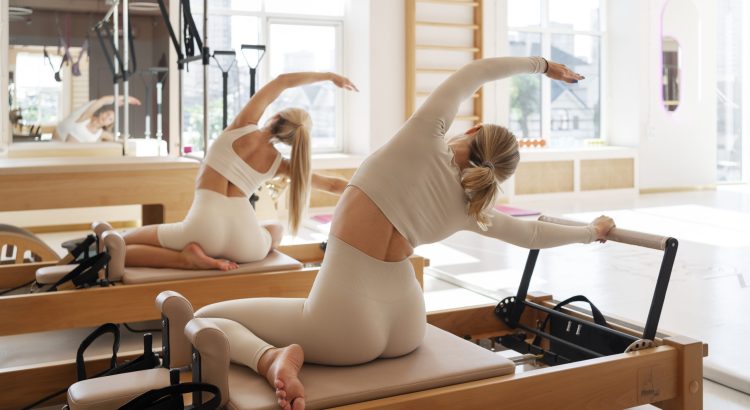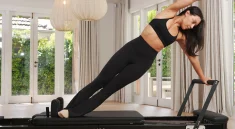Pilates Pila – In 2025, Pilates has solidified itself as more than just a fitness trend; it has become a powerful, transformative workout that benefits both the body and the mind. Once seen as a niche form of exercise, Pilates is now practiced worldwide by people of all ages, fitness levels, and backgrounds. Its focus on core strength, flexibility, and mindful movement has made it a staple in wellness routines. But what’s driving the continued growth of Pilates, and why should you be incorporating it into your fitness regimen this year? In this ultimate guide, we will explore how Pilates can transform your body, from toning muscles to improving posture and even boosting your mental health.
The Core Benefits of Pilates
One of the most significant advantages of Pilates is its focus on strengthening the core muscles. The “core” isn’t just your abs—it’s the entire torso, including the muscles of the lower back, hips, and pelvic floor. A strong core is essential for good posture, stability, and injury prevention.
Pilates exercises engage the deep muscles that support the spine, creating a foundation for all movement. By strengthening these muscles, Pilates helps you build a more stable and resilient body, whether you’re participating in other physical activities or going about your daily routine.
Flexibility and Joint Mobility
Another key benefit of Pilates is improved flexibility and joint mobility. Many modern workouts focus on building strength but neglect flexibility. Pilates, on the other hand, is a balanced approach that includes stretching and lengthening exercises that improve muscle flexibility and joint range of motion.
In 2025, Pilates will continue to play a crucial role in helping people regain mobility and maintain flexibility, especially as they age. By regularly practicing Pilates, you can improve your posture, reduce stiffness, and experience less discomfort in your joints. These benefits are particularly important for those dealing with common issues like back pain or tight shoulders from sitting at desks for long hours.
Posture and Alignment: Stand Taller and Move Better
Pilates exercises emphasize proper alignment and body awareness, which help you achieve better posture. By focusing on how your body moves and correcting any misalignments, you can improve your overall posture both during Pilates sessions and throughout the day.
In 2025, with the increase in sedentary lifestyles and hours spent in front of screens, Pilates will become even more critical in addressing posture-related problems. By practicing Pilates regularly, you’ll notice improved spinal alignment, reduced slouching, and a more upright, confident stance. Not only will this enhance your physical appearance, but good posture also helps prevent injuries and relieves tension in the neck, shoulders, and lower back.
Mind-Body Connection: Pilates for Mental Clarity
While Pilates is widely known for its physical benefits, its positive impact on mental health is equally important. Pilates encourages mindfulness by requiring you to focus on your breath, movement, and alignment. This mindful approach to exercise helps to reduce stress and promote mental clarity.
Whether you’re dealing with stress from work, school, or personal life, Pilates can help you find balance and restore calm.
Pilates for All Ages and Abilities
One of the key reasons Pilates has become so popular is its accessibility. Pilates can be adapted to suit any age group or fitness level, from beginners to elite athletes. In 2025, Pilates will continue to be a widely used method for injury recovery and rehabilitation, especially for those recovering from surgery or experiencing chronic pain.
For older adults, Pilates offers a low-impact way to improve muscle strength, joint mobility, and balance, reducing the risk of falls and enhancing overall quality of life. For younger, more active individuals, Pilates can help improve performance in other sports by increasing flexibility, strength, and body control.
Pilates and Nutrition: The Perfect Pairing for Transformation
In 2025, it’s not just about what you do during your Pilates workout it’s about what you put into your body before and after your sessions. Nutrition plays a significant role in enhancing the benefits of Pilates. Consuming a balanced diet rich in proteins, healthy fats, and whole foods will support muscle recovery, fuel energy, and help you see faster results.
Many Pilates enthusiasts focus on plant-based diets that emphasize whole grains, vegetables, and lean proteins to keep their bodies feeling energized and refreshed. Staying hydrated is also essential for optimal performance, as water helps transport nutrients to your muscles and keeps your body functioning at its best.
The Rise of Virtual Pilates: Training Anytime, Anywhere
In 2025, virtual Pilates classes will continue to thrive, giving people the flexibility to practice Pilates from the comfort of their homes or while traveling. Online Pilates platforms and apps offer a wide range of workout options, from beginner to advanced, ensuring that Pilates is accessible to everyone.
Whether you prefer live virtual classes or on-demand sessions, Pilates enthusiasts will have access to a wealth of resources to keep them motivated and engaged. For those with busy schedules or limited access to local studios, virtual Pilates provides the opportunity to practice whenever and wherever it fits into your lifestyle.
Read More: Why This Rural Hospital’s Telehealth Is Now a National Model
Pilates for a Healthier Future
The future of Pilates in 2025 is bright, and its transformative benefits will continue to evolve.
With its ability to strengthen the core, improve posture, increase flexibility, and reduce stress, Pilates will remain one of the most effective and accessible forms of exercise for all ages and fitness levels. As you begin or continue your Pilates journey in 2025, remember that the consistency and dedication you invest will pay off in the form of a healthier, stronger body and a more peaceful mind



